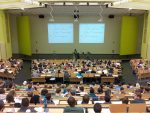
Over 5% of the world’s population or 360 million people have some sort of hearing loss [1]. One way that hearing loss is dealt with is by using hearing improvement devices such as hearing aids and cochlear implants. It is well established that the presence of background noise significantly diminishes the hearing ability of users of these devices.
For this reason, modern hearing aids and cochlear implants incorporate a noise reduction module as part of their signal processing pipeline running on their embedded processors. Although the existing noise reduction modules help hearing aid and cochlear implant users to hear better in some acoustic scenes, there are still many acoustic scenes consisting of various background noise environments in which the existing noise reduction modules are found not to be effective.
Lately, there has been an attempt in developing more advanced noise reduction modules that are adaptive to different background noise environments, e.g. [2, 3], and thus being more effective. In these more advanced signal processing pipelines, a noise classifier is used to identify the noise type. In the Signal and Image Processing Laboratory at the University of Texas at Dallas, we have been developing various noise classifiers as part of these more advanced noise reduction modules.
Many studies have been reported in the literature on environmental noise classification. In our research thrust, we have placed the emphasis on the development of noise classifiers that are computationally efficient, that is to say on those noise classifiers that can be run in real-time on resource-limited embedded processors such as the ones in hearing aids and cochlear implants.
We have carried out the classification both in supervised [4] and in unsupervised modes [5]. In the supervised mode, it is required to first go through a training phase by collecting data from the noise environments of interest and then training a supervised classifier (such as GMM, SVM, Random Forest) for those noise environments. To avoid going through a training phase based on a collected dataset, we have also developed real-time unsupervised classifiers which do not require data collection for training.
In these classifiers, noise types or classes get generated in an on-the-fly manner as they are encountered. Another advantage when using unsupervised classifiers is that a different set of noise types not encountered before can be dealt without the need to go through retraining, which is not the case when using supervised classifiers.
These findings are described in the article entitled Real-Time Unsupervised Classification of Environmental Noise Signals, published in the journal IEEE/ACM Transactions on Audio, Speech, and Language Processing. This work was led by Nasser Kehtarnavaz & Fatemeh Saki from the University of Texas at Dallas.
References:
- http://www.who.int/mediacentre/factsheets/fs300/en/
- V. Gopalakrishna, N. Kehtarnavaz, T. Mirzahasanloo, and P. Loizou, “Real-time automatic tuning of noise suppression algorithms for cochlear implant applications,” IEEE Transactions on Biomedical Engineering, vol. 59, pp. 1691-1700, June 2012.
- I. Panahi, N. Kehtarnavaz, and L. Thibodeau, “Smartphone-based noise adaptive speech enhancement for hearing aid applications,” Proceedings of IEEE International Conference Engineering in Medicine and Biology, Orlando, August 2016.
- A. Sehgal, F. Saki, and N. Kehtarnavaz, “Real-time implementation of voice activity detector on ARM processor of smartphones,” Proceedings of IEEE International Symposium on Industrial Electronics, Edinburgh, Scotland, June 2017.
- N. Alamdari, F. Saki, A. Sehgal, and N. Kehtarnavaz, “An unsupervised noise classification smartphone app for hearing improvement devices,” Proceedings of IEEE Signal Processing in Medicine and Biology Symposium, Philadelphia, Dec 2017.








